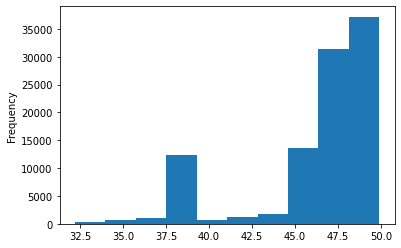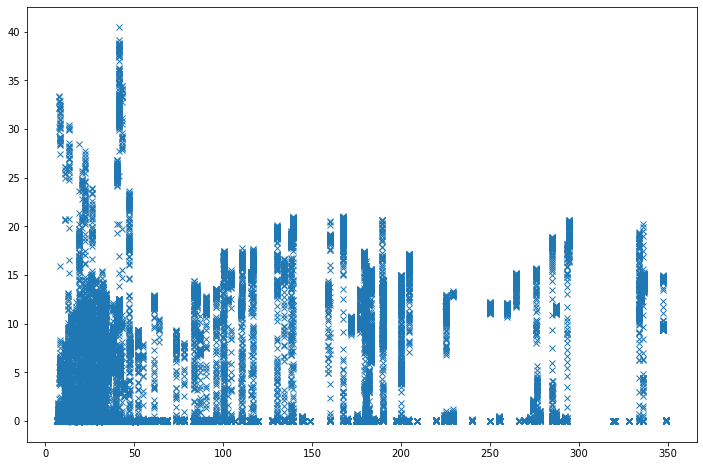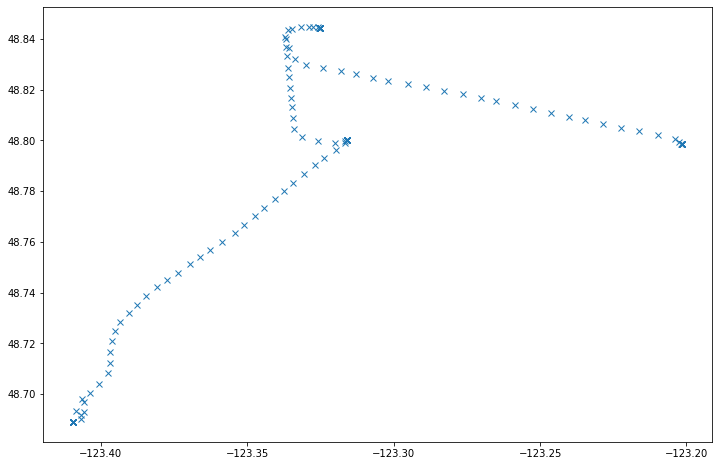Information
Section: Examine the datasets
Goal: Understand the content and the distribution of the datasets we are using in this part.
Time needed: 30 min
Prerequisites: Understanding of AIS data
Examine the datasets¶
Import the data ¶
Now that you understand the meaning of each attribute, you can take a deeper look into the dataset itself, to learn from the distribution of the attributes and their possible relationships and interdependencies. This step will allow you to have a good overview on your data to better solve the diverse tasks for your customers later.
First, you need to load the data again.
import pandas as pd
dynamic_data = pd.read_csv('./dynamic_data.csv')
static_data = pd.read_csv('./static_data.csv')
Dynamic data - let’s do it together ¶
First, we can use various methods to get an overview of the dataset. Let’s have a look at those together:
The method info() returns the count of instances and attributes in the dataset, the method describe() prints the distribution of each numerical attribute.
dynamic_data.info()
<class 'pandas.core.frame.DataFrame'>
RangeIndex: 100000 entries, 0 to 99999
Data columns (total 26 columns):
# Column Non-Null Count Dtype
--- ------ -------------- -----
0 MMSI 100000 non-null int64
1 BaseDateTime 100000 non-null object
2 LAT 100000 non-null float64
3 LON 100000 non-null float64
4 SOG 100000 non-null float64
5 COG 100000 non-null float64
6 Heading 100000 non-null float64
7 VesselName 95405 non-null object
8 IMO 47669 non-null object
9 CallSign 80589 non-null object
10 VesselType 88926 non-null float64
11 Status 70249 non-null object
12 Length 85415 non-null float64
13 Width 71123 non-null float64
14 Draft 42189 non-null float64
15 TripID 100000 non-null int64
16 DepTime 100000 non-null object
17 ArrTime 100000 non-null object
18 DepLat 100000 non-null float64
19 DepLon 100000 non-null float64
20 ArrLat 100000 non-null float64
21 ArrLon 100000 non-null float64
22 DepCountry 100000 non-null object
23 DepCity 100000 non-null object
24 ArrCountry 100000 non-null object
25 ArrCity 100000 non-null object
dtypes: float64(13), int64(2), object(11)
memory usage: 19.8+ MB
RangeIndex: 100000 entries, 0 to 99999: this means that the dataset contains 100000 instances, or 100000 lines. This is the number of AIS messages that are represented in the dataset.Data columns (total 26 columns): this shows that the dataset contains 26 attributes (represented as columns in the dataset).Then follows a list of each attribute, with the number of recorded (non-null) values for each and their type.
Finally, we see a summary of the types and the number of attributes of each type, and the memory used by this dataset.
dynamic_data.head(1)
| MMSI | BaseDateTime | LAT | LON | SOG | COG | Heading | VesselName | IMO | CallSign | ... | DepTime | ArrTime | DepLat | DepLon | ArrLat | ArrLon | DepCountry | DepCity | ArrCountry | ArrCity | |
|---|---|---|---|---|---|---|---|---|---|---|---|---|---|---|---|---|---|---|---|---|---|
| 0 | 367114690 | 2017-01-01 00:00:06 | 48.51094 | -122.60705 | 0.0 | -49.6 | 511.0 | NaN | NaN | NaN | ... | 2017-01-01 00:00:06 | 2017-01-01 02:40:45 | 48.51094 | -122.60705 | 48.51095 | -122.60705 | US | Anacortes | US | Anacortes |
1 rows × 26 columns
Above, we printed the first instance of the dataset. As we see, some attributes have the value NaN. This means that this value is missing (it has not been recorded or saved). This is the reason why some attributes above don’t have 100000 non-null but rather a lower number of instances: some of these values are missing, and we call them missing values.
dynamic_data.describe()
| MMSI | LAT | LON | SOG | COG | Heading | VesselType | Length | Width | Draft | TripID | DepLat | DepLon | ArrLat | ArrLon | |
|---|---|---|---|---|---|---|---|---|---|---|---|---|---|---|---|
| count | 1.000000e+05 | 100000.000000 | 100000.000000 | 100000.000000 | 100000.000000 | 100000.000000 | 88926.000000 | 85415.000000 | 71123.000000 | 42189.000000 | 100000.000000 | 100000.000000 | 100000.000000 | 100000.000000 | 100000.000000 |
| mean | 3.590440e+08 | 46.221127 | -122.893343 | 1.775973 | -16.296728 | 369.527000 | 952.373142 | 60.899165 | 13.653366 | 6.055567 | 668.135890 | 46.222409 | -122.892360 | 46.220749 | -122.897869 |
| std | 5.927431e+07 | 3.850865 | 0.703268 | 4.491950 | 118.459501 | 174.132613 | 237.057544 | 74.529841 | 10.556948 | 4.340102 | 409.245317 | 3.854998 | 0.706539 | 3.846843 | 0.705792 |
| min | 3.160089e+06 | 32.209370 | -125.998590 | -0.100000 | -204.800000 | 0.000000 | 0.000000 | 6.710000 | 0.000000 | 0.000000 | 1.000000 | 32.220640 | -125.995610 | 32.209370 | -125.998590 |
| 25% | 3.160334e+08 | 46.137208 | -123.190290 | 0.000000 | -116.600000 | 205.000000 | 1004.000000 | 18.140000 | 6.430000 | 3.000000 | 317.000000 | 46.137290 | -123.204420 | 46.144140 | -123.192990 |
| 50% | 3.669768e+08 | 47.645370 | -122.688210 | 0.000000 | -49.600000 | 511.000000 | 1018.000000 | 26.490000 | 9.350000 | 4.500000 | 646.000000 | 47.645390 | -122.683800 | 47.645110 | -122.688210 |
| 75% | 3.675157e+08 | 48.621405 | -122.385730 | 0.100000 | 77.900000 | 511.000000 | 1019.000000 | 60.840000 | 18.280000 | 9.100000 | 1001.000000 | 48.621300 | -122.385500 | 48.621200 | -122.385970 |
| max | 9.876543e+08 | 49.890740 | -120.002420 | 42.100000 | 204.700000 | 511.000000 | 1025.000000 | 349.000000 | 50.000000 | 18.800000 | 1520.000000 | 49.890740 | -120.002920 | 49.832120 | -120.002420 |
This function returns some statistics about the distribution of the numerical attributes in the dataset. For example, we can see that the 3rd quartile (‘75%’) of the attribute SOG has a value of 0.1, which means that 75% of the recorded values for SOG are less than 0.1 Knot: we can conclude from this information that most of the recorded datapoints in this dataset concern immobile ships.
Now, with some simple histograms, we can have a visualization the distribution of each attribute in the dataset. This will allow us to look a little deeper than with the above functions.
For that, we use the method plot of a Pandas Series, which allows to produce different types of plot for an attribute, here we choose hist().
dynamic_data['LAT'].plot.hist()
<AxesSubplot:ylabel='Frequency'>

This plot shows the distribution of the latitude attribute in the dataset. We can see that many values are comprised in the range [45.0 ; 50.0]. This means that many positions are recorded in this area, while the range [32.5 ; 45.0] is less dense in recorded positions. If you want to know more about the histograms and the different kinds of plots used in the course, you can visit this page.
We can create this type of plot for every numerical attribute in the dataset.
In the previous cell, try to change the name of the plotted attribute to visualize the other attributes. You can even try to put the name of a non-numerical attribute to see what happens.
<function __main__.plot_hist(att)>
Finally, we can see the different values of each attribute.
For that, we use the method unique():
dynamic_data['VesselType'].unique()
array([ nan, 1012., 1019., 1001., 1025., 1024., 1004., 1018., 1005.,
70., 30., 1020., 99., 1003., 80., 1013., 31., 1002.,
52., 53., 1011., 50., 35., 1023., 69., 37., 7.,
60., 1022., 90., 51., 1010., 0., 79., 71., 1017.])
With this result, and by comparing the values with the AIS documention available here, you can analyze what kind of ships are present in the dataset.
Have a look at the different values for the other attributes by changing the name of the attribute in the previous cell.
<function __main__.get_unique(att)>
Additionaly, we can create a 2 dimensional plot, to represent 2 attributes against each other. For example, on this picture, we represent the attributes longitude and latitude, to get a geographical representation of the recorded datapoints:
import matplotlib.pyplot as plt
plt.figure(figsize = (12, 8))
plt.plot(dynamic_data['Length'], dynamic_data['SOG'], 'x')
[<matplotlib.lines.Line2D at 0x7f66d2f59cc0>]

The datapoints are represented as crosses, and on this plot, each separated blue line is a very likely one recorded trip.
Change the name of the attributes and try to compare other (numerical) attributes.
<function __main__.plot_2att(att1, att2)>
You can also choose to visualize the information of this dataset for only one trip. For example, we want to see the longitude and latitude values for the trip with the TripID 106:
# for one trip
trip = dynamic_data.loc[dynamic_data['TripID'] == 106]
plt.figure(figsize = (12, 8))
plt.plot(trip['LON'], trip['LAT'], 'x')
[<matplotlib.lines.Line2D at 0x7f66d1638668>]

Change the value of the TripID attribute, and the names of the attributes, to plot anything else.
<function __main__.plot_1trip(tripid, att1, att2)>
from IPython.display import IFrame
IFrame("https://h5p.org/h5p/embed/742748", "694", "600")
Static data - your turn ¶
Using the same tools as for the dynamic dataset, you can now analyze the static dataset.
static_data.info()
<class 'pandas.core.frame.DataFrame'>
RangeIndex: 1520 entries, 0 to 1519
Data columns (total 22 columns):
# Column Non-Null Count Dtype
--- ------ -------------- -----
0 TripID 1520 non-null int64
1 MMSI 1520 non-null int64
2 MeanSOG 1520 non-null float64
3 VesselName 1442 non-null object
4 IMO 538 non-null object
5 CallSign 1137 non-null object
6 VesselType 1287 non-null float64
7 Length 1220 non-null float64
8 Width 911 non-null float64
9 Draft 496 non-null float64
10 Cargo 378 non-null float64
11 DepTime 1520 non-null object
12 ArrTime 1520 non-null object
13 DepLat 1520 non-null float64
14 DepLon 1520 non-null float64
15 ArrLat 1520 non-null float64
16 ArrLon 1520 non-null float64
17 DepCountry 1520 non-null object
18 DepCity 1520 non-null object
19 ArrCountry 1520 non-null object
20 ArrCity 1520 non-null object
21 Duration 1520 non-null object
dtypes: float64(10), int64(2), object(10)
memory usage: 261.4+ KB
static_data.describe()
| TripID | MMSI | MeanSOG | VesselType | Length | Width | Draft | Cargo | DepLat | DepLon | ArrLat | ArrLon | |
|---|---|---|---|---|---|---|---|---|---|---|---|---|
| count | 1520.000000 | 1.520000e+03 | 1520.000000 | 1287.000000 | 1220.000000 | 911.000000 | 496.000000 | 378.000000 | 1520.000000 | 1520.000000 | 1520.000000 | 1520.000000 |
| mean | 760.500000 | 3.597421e+08 | 1.034825 | 971.680653 | 56.769590 | 13.104501 | 6.457056 | 50.515873 | 46.354331 | -122.868905 | 46.353671 | -122.871346 |
| std | 438.930518 | 6.263661e+07 | 2.936439 | 198.957887 | 74.739358 | 10.903338 | 4.607529 | 22.693810 | 3.766705 | 0.681947 | 3.762056 | 0.680604 |
| min | 1.000000 | 3.160089e+06 | -0.100000 | 0.000000 | 6.710000 | 0.000000 | 0.000000 | 0.000000 | 32.220640 | -125.995610 | 32.209370 | -125.998590 |
| 25% | 380.750000 | 3.380724e+08 | 0.000000 | 1004.000000 | 14.840000 | 5.500000 | 3.000000 | 31.000000 | 46.168653 | -123.178480 | 46.168460 | -123.168262 |
| 50% | 760.500000 | 3.669802e+08 | 0.012633 | 1019.000000 | 22.340000 | 8.000000 | 4.650000 | 52.000000 | 47.647795 | -122.651365 | 47.646925 | -122.645290 |
| 75% | 1140.250000 | 3.675663e+08 | 0.072000 | 1019.000000 | 41.277500 | 16.350000 | 10.025000 | 70.000000 | 48.656940 | -122.386562 | 48.665710 | -122.386607 |
| max | 1520.000000 | 9.876543e+08 | 20.360811 | 1025.000000 | 349.000000 | 50.000000 | 18.800000 | 99.000000 | 49.890740 | -120.002920 | 49.832120 | -120.002420 |
#static_data[''].plot.hist()
<function __main__.plot_hist(att)>
#static_data[''].unique()
<function __main__.get_unique(att)>
import matplotlib.pyplot as plt
plt.figure(figsize = (12, 8))
#plt.plot(static_data[''], static_data[''], 'x')
<Figure size 864x576 with 0 Axes>
<Figure size 864x576 with 0 Axes>
<function __main__.plot_2att(att1, att2)>
from IPython.display import IFrame
IFrame("https://h5p.org/h5p/embed/742791", "694", "600")

